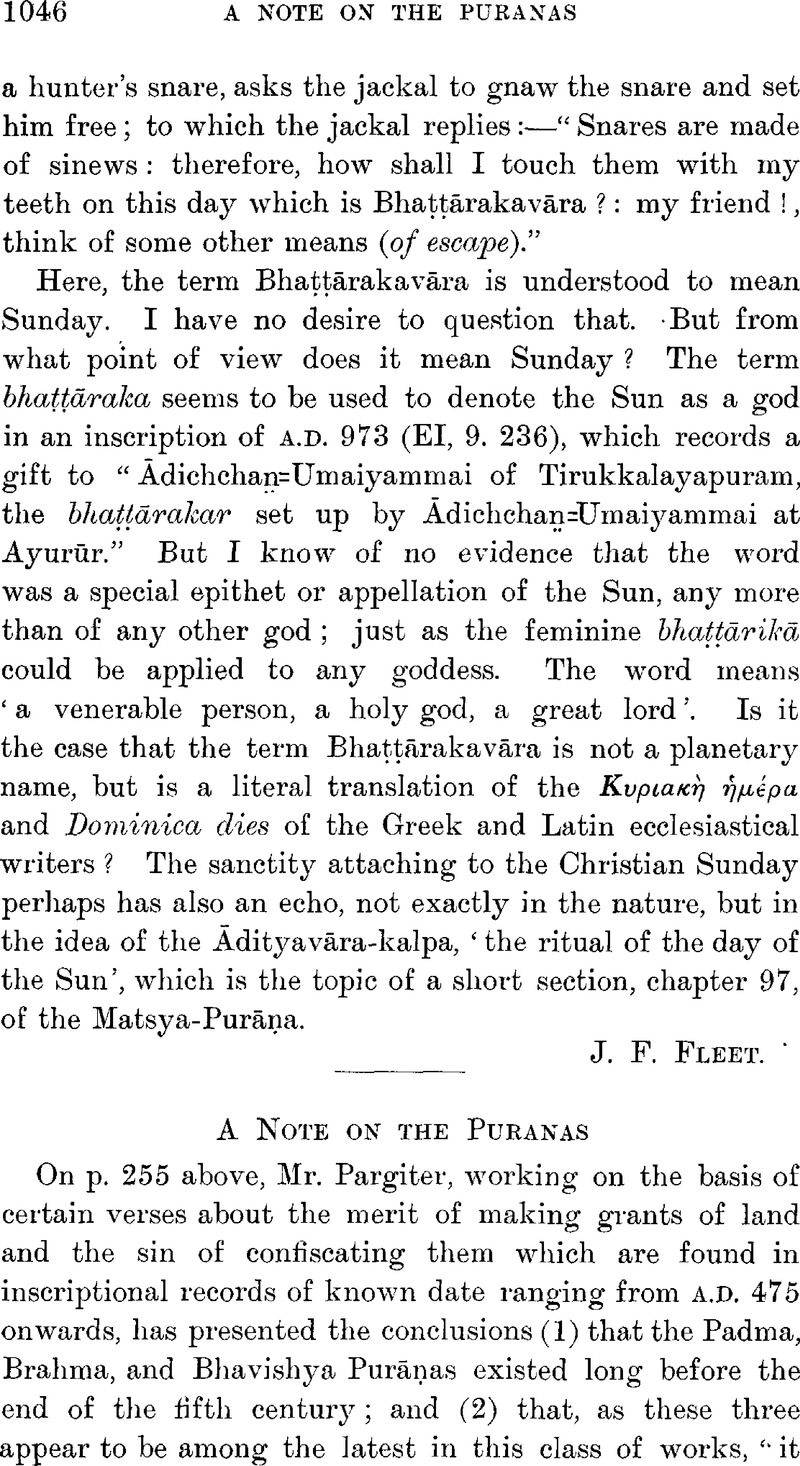No CrossRef data available.

page 1048 note 1 My references are as follows: some of the Purāṇas state also distances between the different orbits; but it does not seem necessary to lengthen matters by including this detail, in which they do not all agree: there is no basis in the astronomy for the distances stated in the Purāṇas.
Agni-Purāṇas, chap. 120, verses 6–8: ed. Ānandāśrama Sanskṛit Series, Poona.
Brahma, chap. 23, verses 5–10: ed. Ānandāśrama Series.
Brahmāṇḍa, chap. 24, verses 119–22: text printed in 1906 at the Srī-Veṅkatēśvara Press, Bombay.
Matsya, chap. 128, verses 71–4: ed. Ānandāśrama Series. It may be added that this work takes the planets in the weekday order in verses 10–20 of chap. 93, the topic of which is the propitiation of them by sacrifices, and in chap. 94, which describes their forms and attributes.
Vāyu, chap. 101, verses 129–35: ed. Ānandāśrama Series.
Bhāgavata, book 5, chap. 22, and chap. 23, para. 1: ed. Burnouf, and text printed in 1905 at the Nirṇayasāgar Press, Bombay. But this work transposes Mercury and Venus: it places Venus next after the nakshatras; then Mercury above Venus; and then Mars, Jupiter, and Saturn. I may remark that the wording of the passage is such as to preclude the possibility of an accidental transposition of the text. In respect of this transposition of the two planets see also the next note.
The Vishṇu does not seem to contain any corresponding passage: but it takes the planets in the same order with the Agni, etc., as far as the Vāyu, in describing their chariots: book 2, chaps. 8, 12: text printed in 1866 at the Vṛittadīpa Press, Bombay; and see Wilson's translation, vol. 2, pp. 237, 299, 304.
The Padma seems to have a passage of the usual kind in part 3, Svargakhaṇḍa, chap. 6, Bhuvādivarṇana, in the recension described by Wilson, from a manuscript, Works, vol. 3, preface, p. 21Google Scholar ff. (see p. 40): but I have not been able to examine it and ascertain its details. In another recension of this work, given in the text printed in 1893–4 at the Ānandāśrama Press. Poona, but not included in that Series, I do not find any corresponding passage: but this text presents the weekday order of the planets in teaching the worship of them in part 5, Srishiṭkhaṇḍa, chaps. 78, 79, 82; and it treats Mercury as the middle planet in chap. 82, verse 6:—Sōmaputra … namas=tē graha-madhyastha ….: this seems to postulate either a quasi-astronomical arrangement of them in the weekday order, or else the same transposition of Mercury and Venus which is made in the Bhāgavata. The same remarks apply to a third recension of this Purāṇa, the text of which was printed in 1895 at the Śri-Veṅḳkatēśvara Press, Bombay: here, the sections teaching the worship of the planets are in part 1, Sṛishtikhaṇḍa, chaps. 80, 81, 82; and the mention of Mercury as the middle planet is in verse 6 of chap. 82.
page 1049 note 1 See remarks under the Bhāgavata-Purāṇa in the preceding note. This transposition of Mercury and Venus (which is of course quite right from one point of view) is found also in a passage in the writings of Cicero; but not, I think, as a view of Cicero himself, though it has been referred to as such.
In the De Divinatione, book 2, § 43, Cicero, speaking in his own person, gives the usual arrangement in the ascending order, from the Moon to Saturn, and expressly says that Mercury is the nearest star to the earth (after the Moon). So, also, in the Somnium Scipionis, § 4, he puts into the mouth of Africanus the same arrangement in the descending order, from Saturn to the Moon. But in the De Natura Deorum, book 2, § 20, Balbus, in speaking of the five planets properly so called, is made to place them in the following order, descending,— Saturn, Jupiter, Mars, Mercury, and then Venus: and he says about Venus that she is “the lowest of the five wanderers, and the nearest to the earth”:— Infima est quinque errantium, terraeque proxima, stella Veneris; ΦωσϕόροςGraece, Lucifer Latine dicitur, cum antegreditur solem [i.e., as a morning star], cum subsequitur autem [i.e., as an evening star] Hesperus.
For the order in the De Divinatione, Cicero cites ratio mathematicorum, “the science of the Mathematicians”. For the order in the Somnium Scipionis, no authority is quoted. For the order given by Balbus, also, in the De Natura Deorum, no authority is specifically quoted: book 1, § 6, however, represents him as holding a very high place among the Stoics: perhaps that may account for the transposition of Mercury and Venus.
page 1051 note 1 Trans. Sachau, 1. 215.
page 1052 note 1 It remains, no doubt, a curious point that the Purāṇas should thus transfer the Sun from the position in the centre of the list, between Venus and Mars, to the place nearest to the earth, and yet should abstain from rearranging the whole series of the planets into the astrological or weekday order. This point may perhaps be considered on some other occasion.